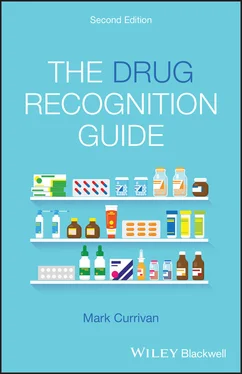2 Joint Formulary Committee (2019). BNF 78: September 2019–March 2020. 78th ed. London: BMJ and the Pharmaceutical Press.
3 King, R.L. (2004). Nurses' perceptions of their pharmacology educational needs. Journal of Advanced Nursing, 45 (4), 392–400 [online]. Wiley Online Library. Available from: doi: https://doi.org/10.1046/j.1365-2648.2003.02922.x.
4 Manias, E. (2009). Pharmacology content in undergraduate nursing programs: is there enough to provide safe and effective care? International Journal of Nursing Studies, 46 (1), 1–3.
5 Pearson, M., Carter, T., McCormick, D. et al. (2018). Pharmacology training in mental health nurse education: justification for an increase in frequency and depth in the UK. Nurse Education Today, 62, 36–38.
6 Royal Pharmaceutical Society (2016). A competency framework for all prescribers. Royal Pharmaceutical Society [online], 2. Available from: https://www.rpharms.com/resources/frameworks/prescribers-competency-framework.
7 World Health Organisation (2013). The use of stems in the selection of International Nonproprietary Names (INN) for pharmaceutical substances. Stem book 2013 [online]. Available from: https://www.who.int/entity/medicines/services/inn/StemBook_2013_Final.pdf.
1 Drugs that affect the gastrointestinal system
Aminosalicylates
Antimuscarinics
Antispasmodics
Direct‐acting smooth muscle relaxants
H2‐receptor antagonists
Laxatives
Proton pump inhibitors (PPIs)

Note:antimuscarinics are drugs that can also be used to treat respiratory disorders (see Chapter 4), bradycardia, genitourinary disorders and Parkinson's disease (see Chapter 5) and nausea and vomiting (see Chapter 7).
Aminosalicylates are anti‐inflammatory drugs given to treat gastric inflammation associated with conditions such as ulcerative colitis and Crohn's disease. Aminosalicylates are derivatives of salicylic acid: a natural substance originally obtained from willow bark, which has been used as a medicine for thousands of years (Hippocrates had written about the therapeutic properties of willow as far back as 400 B.C.). The Latin term for willow is ‘salix’, from which is derived the word ‘salicylic’. The active ingredient in willow – salicin – metabolises in the body into salicylic acid. In the nineteenth century salicylic acid began to be produced synthetically. In addition to aminosalicylates, salicylic acid is now the basic ingredient in a number of related anti‐inflammatory drugs, including aspirin (acetyl salicylic acid: see Chapters 3and 6). Amino salicylates have generic names that contain the letters ‘‐ sal‐’, resulting in names ending in either ‘‐ salazide’ or ‘‐ salazine’:
Balsalazide
Mesalazine
Olsalazine
Sulfasalazine

Despite sharing the same ‘ sulfa‐’ prefix, do not mistake the aminosalicylate sulfasalazinefor one of the sulfonamide class antibiotics (i.e., sulfamethoxazole: see Chapter 9).

Do not mistake the antihypertensive drug hydralazinefor an aminosalicylate with a name ending in ‘‐ salazine’. Hydralazineis a direct‐acting vasodilator of a type known as a ‘ hydrazinophth alazine’.
Antispasmodics are drugs used to bring symptomatic relief from gastrointestinal muscle spasm in patients with conditions such as irritable bowel syndrome (IBS) (Ruepert et al., 2011). The term ‘antispasmodic’ simply describes what these drugs do (relaxing intestinal smooth muscle) and does not refer to just one type or class of drug. Medicines that have antispasmodic (or ‘spasmolytic’) properties include antimuscarinics and direct‐acting smooth muscle relaxants.
Antimuscarinic antispasmodics
Antimuscarinics work by reducing intestinal motility (see list of other antimuscarinic drugs in Chapter 5).
Atropine
Dicycloverine
Hyoscine butylbromide
Propantheline
Direct‐acting smooth muscle relaxants
Direct‐acting smooth muscle relaxants are medicines used to help relieve the symptoms of abdominal colic and IBS (Ford et al., 2008).
Alverine
Mebeverine
Peppermint oil

The suffix ‘‐ verine’ is one that can be applied to any drug with smooth muscle relaxing properties (i.e., the antimuscarinic propiverine(used to relax smooth muscle in the bladder: see Chapter 5) and the phosphodiesterase inhibitor papaverine(see Chapter 8).
An amino acid called his tidineis a precursor to histamine; with histamine‐2 playing an important role in helping stimulate gastric acid secretion. H2‐receptor antagonists (the ‘H’ stands for histamine) are a particular type of antihistamine that works by selectively blocking histamine‐2 receptors (also see H1 receptor‐blocking ‘antihistamines’: see Chapter 5).
H2‐receptor antagonists reduce gastric acid secretions and so help protect the stomach's mucosal lining from acid erosion (Keshav and Bailey, 2013, pp. 43, 73–75). Cimetidine – the first H2‐receptor antagonist – was introduced in 1976 and soon became the first prescription drug in the world to achieve annual sales worth more than one billion dollars, ushering in (for better or worse) the era of ‘blockbuster’ selling drugs.
H2‐receptor antagonists are prescribed to treat gastrointestinal disorders such as gastric or duodenal ulcers, oesophageal reflux and dyspepsia (Puttmann and Roett, 2011). H2‐receptor antagonists (often referred to as ‘H2 blockers’) can be recognised by generic drug names ending with the letters ‘‐ tidine’:
Cimetidine
Famotidine
Nizatidine
Ranitidine

Note a few exceptions: drugs with names ending in ‘‐ tidine’ but which are not H2‐receptor antagonists: azacitidine(a chemotherapy drug: see Chapter 10) and hexetidine(an antiseptic mouth wash).
Laxatives (also known as aperients or purgatives) are given to treat or prevent constipation. There are various types: bulk‐forming laxatives (i.e., ispaghula husk and sterculia) that act by increasing faecal mass; osmotic laxatives (i.e., lactulose) that draw water into the bowel; faecal softeners (i.e., docusate sodium and poloxamer ‘188’) that ease rectal straining and stimulant laxatives (i.e., bisacodyl, dantron, senna and sodium picosulfate) that promote peristalsis and bowel motility. Co‐danthramer(which combines dantronwith poloxamer‘ 188’) and co‐danthrusate(which combines dantronwith doc usatesodium) are both compound laxatives (hence their ‘ co‐’ prefix). Prucalopride is a selective 5HT‐4 receptor agonist: it promotes bowel motility by enhancing the transmission of serotonin‐4 (5HT‐4) to 5HT‐4 receptors in the colon.
Читать дальше













